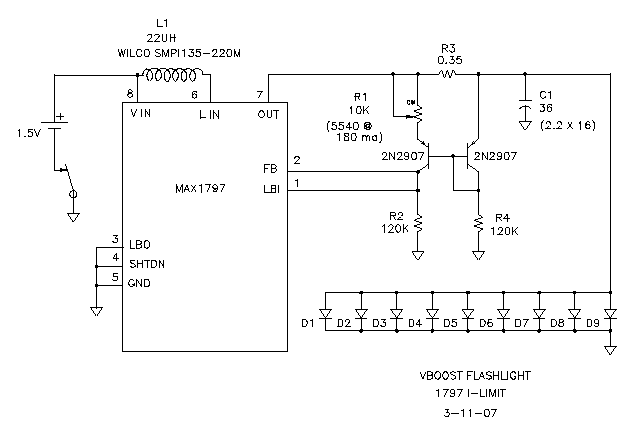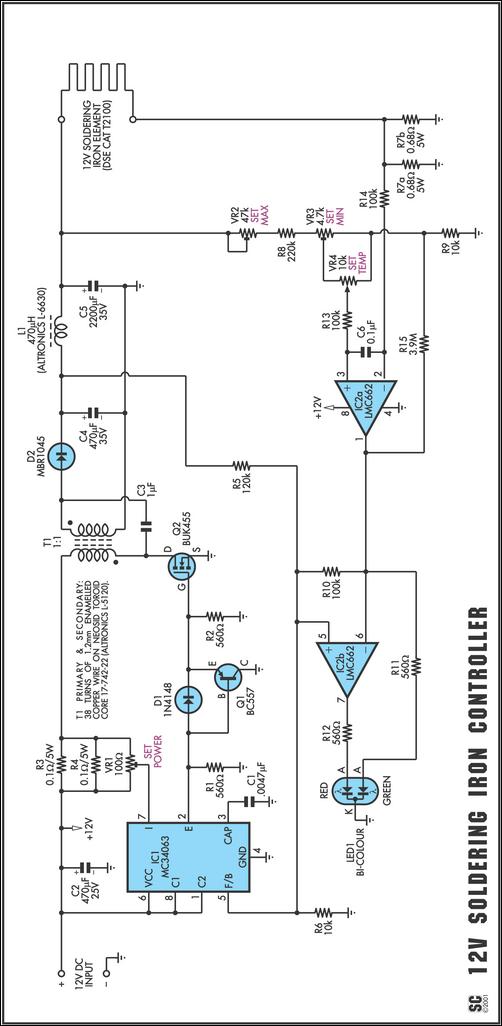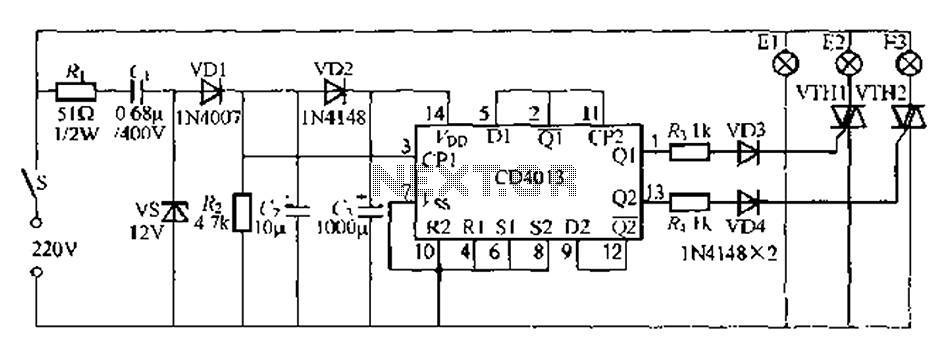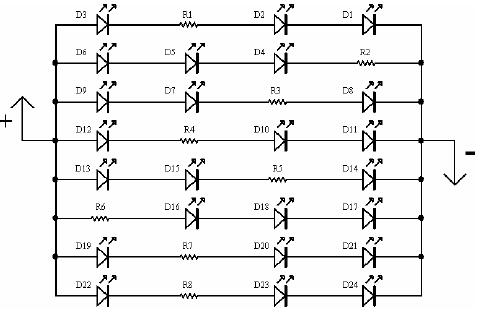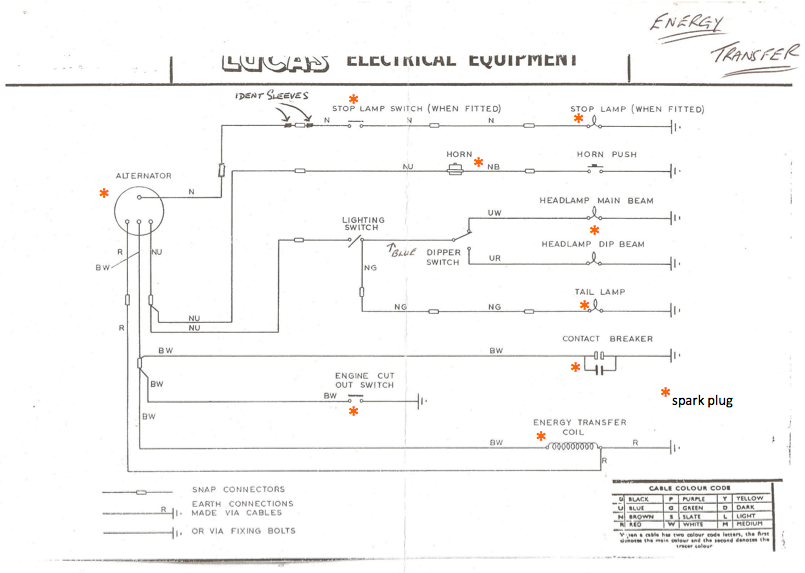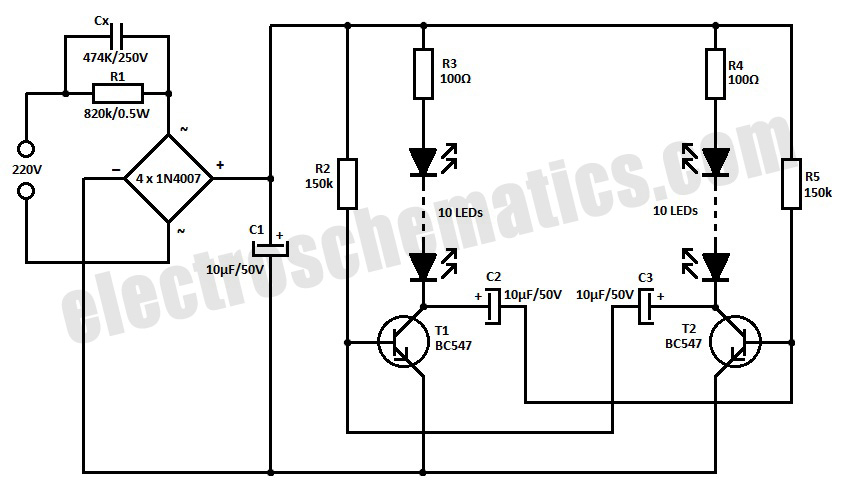
mains operated led night lamp
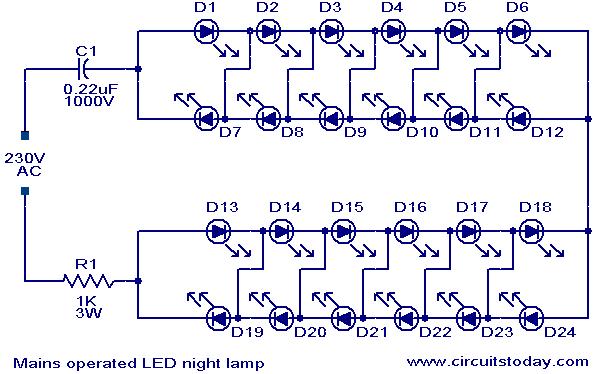
This is a simple and effective LED-based night lamp circuit that can be powered directly from a 230V mains supply. The circuit uses a total of 24 white LEDs and produces an output of approximately 15W. The resistor R1 and capacitor C1 provide essential current limiting. The circuit is designed to be sufficiently immune to voltage spikes and surges. It is advisable to rectify the mains power and utilize a filter capacitor, as flickering in an LED array can be quite intolerable for many users. Most LED lamps built typically use a resistive voltage divider instead of a capacitor, which enhances long-term reliability and reduces the likelihood of LED failure due to potential overloads at switch-on. When there is a high contrast between the light and its surroundings, as well as between the on and off phases of the light, it is easy to perceive flicker at 100 Hz when moving one’s eyes past the light source. The duration of the off period is critical; lights powered by UK mains at 100 Hz usually exhibit off periods of about 5 ms, which are less noticeable compared to some car tail lights that operate at 1 ms on and 9 ms off. Some car tail lights are now lit at approximately 400 Hz, which, while still visible, is less distracting. It is important to consider that even if only a small percentage of individuals find 100/120 Hz lighting intolerable, it is not advisable to subject anyone to such lighting conditions. Scotopic vision is more sensitive to flicker than photopic vision, making flicker more noticeable in low light conditions, especially when the light source is in peripheral vision. Additionally, flicker can be detected at higher frequencies when the eyes are in motion, particularly at night, as the movement can cause lights to appear to leave a trail. Flashing lights create an unexpected broken trail, which can be distracting. Similar effects have been observed with fluorescent lighting. High-speed recordings of eye movements reveal that under 100 Hz lighting, the eyes can overshoot targets if they happen to be in a dark area at that moment.
The LED-based night lamp circuit is designed for efficient operation directly from a 230V AC mains supply, utilizing 24 white LEDs arranged to provide a combined output of around 15W. The circuit employs a resistor (R1) and a capacitor (C1) to limit the current flowing through the LEDs, ensuring that they operate within their rated specifications to prevent premature failure. The inclusion of these components not only helps in current regulation but also enhances the circuit's resilience against voltage spikes and surges commonly found in mains electricity.
To improve the user experience, it is recommended to rectify the AC mains supply using a bridge rectifier, followed by a smoothing capacitor. This approach minimizes flickering, which can be particularly bothersome in LED arrays. The flickering effect is often exacerbated by the rapid on-off cycling of the LEDs, which becomes more pronounced in conditions of high contrast between light and dark surroundings.
The circuit's design also considers the human visual response to flicker. Research indicates that scotopic vision, which is responsible for low-light vision, is more sensitive to flicker than photopic vision, which operates under brighter conditions. Therefore, in low-light environments, the flickering of lights can be more distracting and noticeable, especially when the light source is positioned in the peripheral field of vision.
In summary, the night lamp circuit not only serves its primary function of providing illumination but also takes into account the physiological effects of flicker on human vision. By implementing rectification and smoothing techniques, along with careful component selection, the circuit aims to deliver a reliable and comfortable lighting experience that minimizes visual distractions.Here is a simple and powerful LED based night lamp circuit that can be operated directly from the 230V mains supply. The are total 24 white LEDs used and the lamp produces an output of around 15W. The resistance R1 and capacitor C1 provides necessary current limiting. The circuit is sufficiently immune against voltage spikes and surges. I would str ongly recommend that you rectify the mains power and use a filter capacitor, the flicker when powering an LED array like that is quiet intolerable to most people. Most LED lamps I built, have not a capacitor but a resistive voltage divider, for more long term reliability and reducing the chance of the LED`s to fail, when the capacitor has a bad day at switch on and overload the 1k resistor.
If there is high contrast, both between the light and its surroundings, and between the on and off phases of the light, it is quite easy to see 100 Hz flicker I move my eyes past the light. The off period is more important than the frequency. Lights lit from UK mains at 100 Hz usually have off periods of about 5 ms and aren`t as bad as the tail lights of some cars that are 1 ms on and 9 ms off.
I can see that they are flashing at any distance from about 5 metres to a couple of km. Some car tail lights are now lit at about 400 Hz, which is still visible but isn`t nearly as distracting. I haven`t had a chance to get a `scope on one of them to measure for sure. Also, it doesn`t really matter that only a few percent people find 100 / 120 Hz lighting intolerable, you shouldn`t be subjecting them to lighting like that, any more than you should put door lintels 1.
8m off the ground and only 5% of visitors knock themselves out. Scotopic vision is more sensitive to flicker than photopic vision so you`ll notice flicker more under low light conditions if the source is in your peripheral field of vision. True, but you can detect flicker at still higher frequencies if you move your eyes, especially at night.
The movement of the eye causes a light to leave a trail, which one comes to expect. Flashing lights leave a broken trail, which isn`t expected, so becomes distracting. A similar effect has been found with florescent lighting. When high-speed recordings are made of eye movements when people look from one object to another, in 100Hz lighting the eyes often overshoot the target, if it happens to be dark at that moment. 🔗 External reference
The LED-based night lamp circuit is designed for efficient operation directly from a 230V AC mains supply, utilizing 24 white LEDs arranged to provide a combined output of around 15W. The circuit employs a resistor (R1) and a capacitor (C1) to limit the current flowing through the LEDs, ensuring that they operate within their rated specifications to prevent premature failure. The inclusion of these components not only helps in current regulation but also enhances the circuit's resilience against voltage spikes and surges commonly found in mains electricity.
To improve the user experience, it is recommended to rectify the AC mains supply using a bridge rectifier, followed by a smoothing capacitor. This approach minimizes flickering, which can be particularly bothersome in LED arrays. The flickering effect is often exacerbated by the rapid on-off cycling of the LEDs, which becomes more pronounced in conditions of high contrast between light and dark surroundings.
The circuit's design also considers the human visual response to flicker. Research indicates that scotopic vision, which is responsible for low-light vision, is more sensitive to flicker than photopic vision, which operates under brighter conditions. Therefore, in low-light environments, the flickering of lights can be more distracting and noticeable, especially when the light source is positioned in the peripheral field of vision.
In summary, the night lamp circuit not only serves its primary function of providing illumination but also takes into account the physiological effects of flicker on human vision. By implementing rectification and smoothing techniques, along with careful component selection, the circuit aims to deliver a reliable and comfortable lighting experience that minimizes visual distractions.Here is a simple and powerful LED based night lamp circuit that can be operated directly from the 230V mains supply. The are total 24 white LEDs used and the lamp produces an output of around 15W. The resistance R1 and capacitor C1 provides necessary current limiting. The circuit is sufficiently immune against voltage spikes and surges. I would str ongly recommend that you rectify the mains power and use a filter capacitor, the flicker when powering an LED array like that is quiet intolerable to most people. Most LED lamps I built, have not a capacitor but a resistive voltage divider, for more long term reliability and reducing the chance of the LED`s to fail, when the capacitor has a bad day at switch on and overload the 1k resistor.
If there is high contrast, both between the light and its surroundings, and between the on and off phases of the light, it is quite easy to see 100 Hz flicker I move my eyes past the light. The off period is more important than the frequency. Lights lit from UK mains at 100 Hz usually have off periods of about 5 ms and aren`t as bad as the tail lights of some cars that are 1 ms on and 9 ms off.
I can see that they are flashing at any distance from about 5 metres to a couple of km. Some car tail lights are now lit at about 400 Hz, which is still visible but isn`t nearly as distracting. I haven`t had a chance to get a `scope on one of them to measure for sure. Also, it doesn`t really matter that only a few percent people find 100 / 120 Hz lighting intolerable, you shouldn`t be subjecting them to lighting like that, any more than you should put door lintels 1.
8m off the ground and only 5% of visitors knock themselves out. Scotopic vision is more sensitive to flicker than photopic vision so you`ll notice flicker more under low light conditions if the source is in your peripheral field of vision. True, but you can detect flicker at still higher frequencies if you move your eyes, especially at night.
The movement of the eye causes a light to leave a trail, which one comes to expect. Flashing lights leave a broken trail, which isn`t expected, so becomes distracting. A similar effect has been found with florescent lighting. When high-speed recordings are made of eye movements when people look from one object to another, in 100Hz lighting the eyes often overshoot the target, if it happens to be dark at that moment. 🔗 External reference
